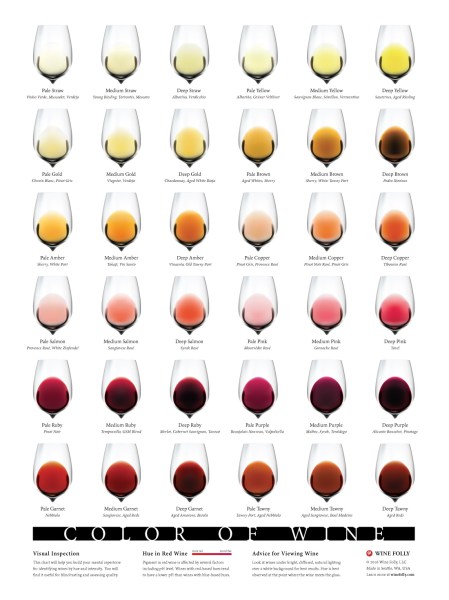Tasting wine like a pro.
There are four major categories to consider when it comes to tasting wine: sight, nose, palate, conclusion.
This is the same process wine professionals and enthusiasts are taught all over the world. Of course, there are always slight variations and more in depth detail to the approach, but it ultimately comes down to these four basic concepts.
Sight.
-
Color
-
Opacity
-
Viscosity
The best way to evaluate the color and opacity of a wine is by holding the glass over a white backdrop (table cloth, napkin, paper). Is it a pale straw color that you can see your hand through or is it a deep purple that you can’t see anything through? There is a whole spectrum of wine colors not just red, white, and rosé. The chart below is one of the best examples I have come across. You can check out their other charts and maps at www.winefolly.com. Next, swirl your glass to see if there are any wine legs or tears present. If they are slow moving it indicates the wine is either high in alcohol or has a lot of residual sugar.
Nose.
-
Intensity
-
Aromas
Intensity refers to how powerful the aroma is. Can you smell the wine and bouquet before you get your nose to the glass or are you having to stick your nose in the glass to smell anything? Aromatic wines like Sauvignon Blanc and Riesling are usually medium plus to high intensity. To smell the wine hold the glass under your nose and sniff once to gage intensity and to prep your nose, then swirl your wine and continue to smell and evaluate. There are several aromas to look for: primary, secondary, and tertiary. Primary aromas consist of fruit, florals, herbs, vegetable, and earthiness. Secondary aromas consist of butter, mushroom, bread, and several others. Tertiary aromas come from aging such as dried herbs, tobacco, coffee, vanilla, coconut, and nuts. The best way to know what you are tasting is by trying and smelling these in real life.
Palate.
-
Flavor and Aromas
-
Structure
To taste the wine take a large sip and coat the entire mouth. Think about swishing it around like mouthwash. Then, continue to sip the wine attempting to identify particular flavors. Do they match what you smelled or are there new aromas present? The palate is a good way to confirm what you are smelling and to find new flavors. A good starting point for everyone is trying to identify at least 3 fruits and 3 other flavors. The structure of a wine consists of sweetness, acidity, tannin, alcohol, body, and finish. So how do you detect these in a wine? Dry to sweet is fairly self explanatory scale with Cabernet Sauvignon being dry and Moscato or Port being sweet. Acidity is felt by mouth watering- similar sensation to eating a lemon. The higher the acidity the more your mouth will water. Tannins are felt by a drying out sensation in the mouth or like something is covering your teeth when you rub your tongue against them. Alcohol is felt by a warm sensation in your throat or chest. A low alcohol wine would be 10% abv or lower and a high alcohol would be over 14% abv. Body refers tot the weight of the wine. Is it light or heavy in the mouth? Wines with lower alcohol and tannin tend to be lighter bodied where wines with higher alcohol, sweetness, or tannin are full bodied. Finally the finish. How do you taste the wine after you swallow or spit?
Conclusion.
-
Is it balanced?
-
Did you like it? What did you like?
Balance refers to if all the traits in the wine work together. Sometimes they do and sometimes something dominates other flavors or characteristics. Most importantly, you should rate the wine on a scale on how well you liked it. Figuring out what you like in a wine will help you discover other grape varieties or styles that you might like. There are thousands of grapes varieties and thousands of wine regions in the world. The possibilities are endless. Don’t be afraid to try something new and explore!

